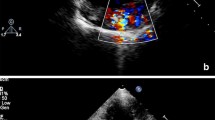Abstract
Background
The study examined the influence of significant tricuspid regurgitation (TR) on the immediate, early and mid-term outcomes of patients with severe mitral stenosis (MS) undergoing balloon mitral valvotomy (BMV).
Methods
Among the 818 consecutive patients who underwent elective BMV in this institute from 1997 to 2003, 114 had significant TR. After propensity score–matched analysis, the data of 93 patients with significant TR were compared with the data of 93 patients who had no significant TR at the baseline. Outcomes were assessed immediately, at 1 year (early) and at 5 years (mid-term) after BMV.
Results
Patients with significant TR presented more frequently with NYHA class III–IV status, atrial fibrillation (AF), severe pulmonary hypertension (PH), advanced mitral valve disease as assessed by echocardiographic score > 8, and with history of previous BMV. After propensity score–matched analysis, it was found that the immediate procedural success (54.8% vs. 58.1%, P = 0.650), immediate in-hospital events and prevalence of AF and heart failure at 1 year of follow-up were comparable between the two groups. At 5 years after BMV, the significant TR group had higher prevalence of heart failure and AF, greater attrition in mitral valve area (MVA) and higher pulmonary artery (PA) pressure.
Conclusions
Significant TR identifies a sicker patient population with MS. Even though patients with significant TR have comparable immediate and early outcomes after BMV, they have poor outcomes on mid-term follow-up. Longer follow-up with more patients is needed to assess survival aspect of TR on patients undergoing BMV and also to look at the need for interventions to address the significant TR, apart from the mitral valve interventions.

Similar content being viewed by others
References
Lee SP, Kim HK, Kim KH, et al. Prevalence of significant tricuspid regurgitation in patients with successful percutaneous mitral valvuloplasty for mitral stenosis: results from 12 years’ follow-up of one centre prospective registry. Heart. 2013;99:91–7.
Boyaci A, Gokce V, Topaloglu S, Korkmaz S, Goksel S. Outcome of significant functional tricuspid regurgitation late after mitral valve replacement for predominant rheumatic mitral stenosis. Angiology. 2007;58:336–42.
Shiran A, Sagie A. Tricuspid regurgitation in mitral valve disease incidence, prognostic implications, mechanism, and management. J Am Coll Cardiol. 2009;53:401–8.
Sagie A, Schwammenthal E, Newell JB, et al. Significant tricuspid regurgitation is a marker for adverse outcome in patients undergoing percutaneous balloon mitral valvuloplasty. J Am Coll Cardiol. 1994;24:696–702.
Ruel M, Rubens FD, Masters RG, Pipe AL, Bedard P, Mesana TG. Late incidence and predictors of persistent or recurrent heart failure in patients with mitral prosthetic valves. J Thorac Cardiovasc Surg. 2004;128:278–83.
Mohanan Nair KK, Pillai HS, Thajudeen A, et al. Immediate and long-term results following balloon mitral valvotomy in patients with atrial fibrillation. Clin Cardiol. 2012;35:E35–9.
Pillai HS. Percutaneous mitral valvotomy: Jaypee brothers, New Delhi; 2nd Edition 2018. Pages 60–66.
Matsuyama K, Matsumoto M, Sugita T, Nishizawa J, Tokuda Y, Matsuo T. Predictors of residual tricuspid regurgitation after mitral valve surgery. Ann Thorac Surg. 2003;75:1826–8.
Song H, Kang DH, Kim JH, et al. Percutaneous mitral valvuloplasty versus surgical treatment in mitral stenosis with severe tricuspid regurgitation. Circulation. 2007;116:I-246–50.
Arora R, Khalilullah M, Gupta MP, Padmavati S. Mitral restenosis. Incidence and epidemiology. Indian Heart J. 1978;30:265–8.
Nanjappa MC, Dorros G, Hemann SK, et al. The Indian experience of percutaneous transvenous mitral commissurotomy: Comparison of the triple lumen and double lumen variable sized single balloon with regard to procedural outcome and cost savings. J Interv Cardiol. 1998;11:107–12.
Rathakrisnnan SS, Ramasamy R, Kaliappan T, Gopalan R, Palanimuthu R, Anandhan P. Immediate outcome of balloon mitral valvuloplasty with JOMIVA balloon during pregnancy. J Clin Diagn Res. 2017;11:OC18–20.
Nair KK, Pillai HS, Titus T, et al. Persistent pulmonary artery hypertension in patients undergoing balloon mitral valvotomy. Pulm Circ. 2013;3:426–31.
Elmaghawry LM, El-Dosouky II, Kandil NT, Sayyid-Ahmad AMS. Pulmonary vascular resistance and proper timing of percutaneous balloon mitral valvotomy. Int J Card Imaging. 2018;34:523–9.
Chorin E, Rozenbaum Z, Topilsky Y, et al. Tricuspid regurgitation and long-term clinical outcomes. Eur Heart J Cardiovasc Imaging. 2020;21:157–65.
Ingraham BS, Pislaru SV, Nkomo VT, et al. Characteristics and treatment strategies for severe tricuspid regurgitation. Heart. 2019;105:1244–50.
Prihadi EA, Delgado V, Leon MB, Enriquez-Sarano M, Topilsky Y, Bax JJ. Morphologic types of tricuspid regurgitation: characteristics and prognostic implications. JACC Cardiovasc Imaging. 2019;12:491–9.
Asmarats L, Taramasso M, Rodés-Cabau J. Tricuspid valve disease: diagnosis, prognosis and management of a rapidly evolving field. Nat Rev Cardiol. 2019;16:538–54.
Acknowledgements
We would like to acknowledge the guidance and technical support provided Dr. Oomen P. Mathew in statistical analysis.
Funding
Nil
Author information
Authors and Affiliations
Corresponding author
Ethics declarations
Conflict of interest
The authors declare that they have no conflict of interest.
Research involving human participants and/or animals
We confirm that the retrospective study was approved by the SCTIMST Institute Ethics Committee and certify that the study was performed in accordance with the ethical standards as laid down in the 1964 Declaration of Helsinki and its later amendments.
Informed consent
Informed consent was not taken due to retrospective nature of the study which was approved by SCTIMST Institute Ethics Committee.
Ethical approval
Retrospective study approved by SCTIMST Institute Ethics Committee.
Additional information
Publisher’s note
Springer Nature remains neutral with regard to jurisdictional claims in published maps and institutional affiliations.
Rights and permissions
About this article
Cite this article
Nair, K.K.M., Valaparambil, A., Sasidharan, B. et al. Immediate, early and mid-term outcomes following balloon mitral valvotomy in patients having severe rheumatic mitral stenosis with significant tricuspid regurgitation. Indian J Thorac Cardiovasc Surg 36, 483–491 (2020). https://doi.org/10.1007/s12055-020-01012-0
Received:
Revised:
Accepted:
Published:
Issue Date:
DOI: https://doi.org/10.1007/s12055-020-01012-0




